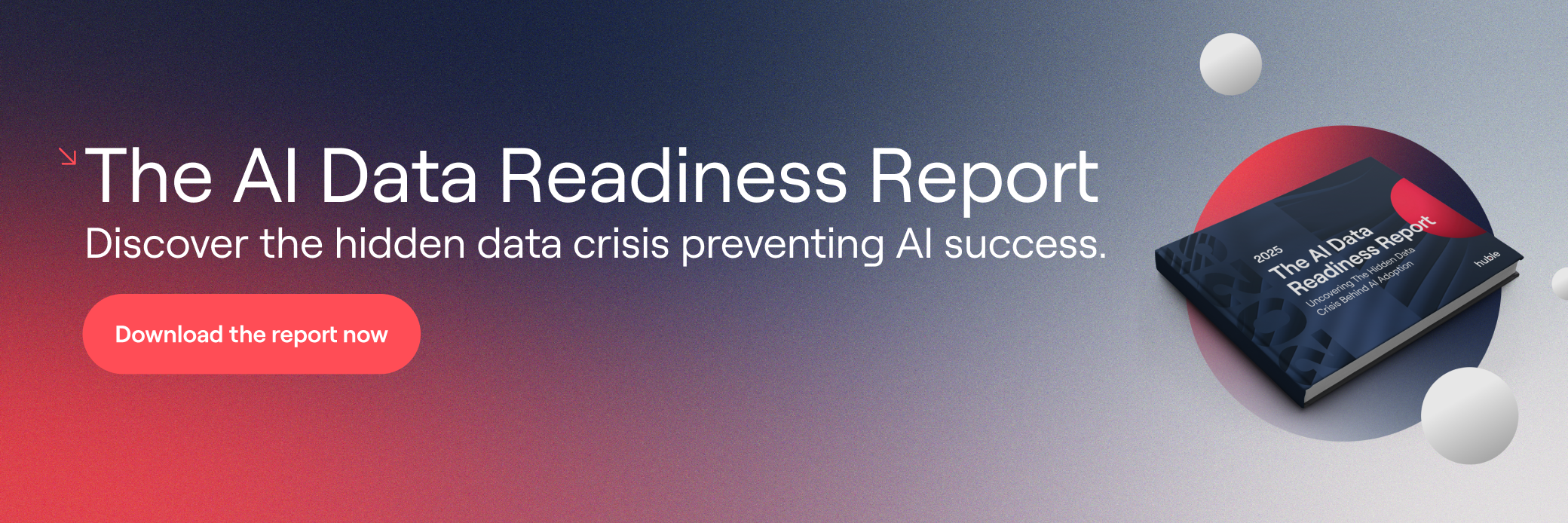In this article, we’ll explore what the AI leaders of 2025 are doing differently right now, and how your business can move from aspiration to action.
In the race to adopt AI, most businesses are sprinting in the wrong direction. While AI headlines promise automation, efficiency, and breakthrough innovation, the reality inside most organizations is far messier.
Tools are purchased without strategy. Data is scattered across platforms. And AI features are left unused or misunderstood.
According to the AI Data Readiness Report, just 8.6% of businesses are fully AI-ready. That means over 90% are either still experimenting, or worse, stalling, despite investing heavily in AI capabilities. So what separates the leaders from the laggards?
It’s not just about ambition. It’s about preparation.
The companies making real progress with AI today aren’t chasing every new tool, they’re building a strong foundation that ensures AI is not only implemented, but effective. And that starts with getting serious about data, governance, and strategy.
Step 1: Audit your data, don’t assume it’s ready
Before any AI tool can deliver real value, it needs access to the right fuel: structured, centralized, high-quality data.
Yet, many organizations are still operating under the false assumption that their data is “good enough.” It’s not.
The first critical step toward AI readiness isn’t implementation, it’s assessment. Businesses need to rigorously audit their data ecosystems, asking questions like:
- Where is our data stored?
- Who owns it?
- How clean, consistent, and complete is it?
- Which systems are already using AI, officially or unofficially?
And here’s a reality many companies are missing: you’re likely already using AI tools—whether you know it or not.
From marketing automation platforms to customer support tools, AI is being baked into more and more business software. That means your data is already being fed into models that are generating insights, making decisions, and creating content.
But if you haven’t audited where those tools are pulling data from, or whether that data is trustworthy, you’re flying blind.
This isn’t just an IT concern. It’s a business-critical priority.
If your data is fragmented, inconsistent, or siloed, your AI outputs will be too. And instead of unlocking efficiency, you risk amplifying the very problems you’re trying to solve.
The goal of this audit isn’t just to clean house, it’s to lay the groundwork for strategic, scalable AI use across the business.
Step 2: Use what you’ve got: the low-hanging fruit of AI adoption
Here’s the good news: you may not need to invest in new AI platforms right away. In fact, the fastest way to move from ambition to preparation is to activate the AI features already built into the tools you’re using today.
Start by looking at your existing software stack, CRM, ERP, marketing automation, accounting, customer service platforms. Many of these systems already include AI-powered features, from predictive analytics to smart content recommendations to AI agents that automate tasks.
The problem? In many organizations, these features are sitting idle because teams don’t know they exist or don’t understand how to use them.
This is your lowest-hanging fruit. If you’re a HubSpot customer, for example, AI is already woven into the platform, from content assistants to lead scoring to customer service chatbots. Many of these features are switched on by default and require little-to-no setup to start generating value.
If your current tools don’t offer AI features, that’s a red flag. It either means you’ll need to build those capabilities in-house or switch to platforms that do. And with AI evolving rapidly, that gap will only widen over time.
Activating native AI functionality serves a double benefit:
- It delivers quick wins and visible ROI.
- It helps your teams get comfortable with AI workflows, terminology, and prompting, without the overhead of launching entirely new systems.
This kind of “embedded adoption” is a smart, strategic first move that builds confidence across the organization, and sets the stage for more advanced applications later.
Step 3: Avoid the trap of point solutions
In the rush to “do something” with AI, many companies make a costly mistake: they start buying isolated AI tools for specific use cases, chatbots here, content generators there, forecasting tools somewhere else.
The result? A patchwork of point solutions that don’t talk to each other and only worsen your existing data silos.
Each standalone tool may seem useful in isolation, but collectively, they introduce serious risks:
- Fragmented data: Every tool captures and processes data in its own way, further decentralizing your information ecosystem.
- Inconsistent insights: Disconnected tools mean disconnected logic, so different teams get conflicting outputs and recommendations.
- Mounting complexity: Managing multiple systems increases the burden on IT, bloats your software stack, and slows down adoption across teams.
AI doesn't just use data, it creates it. And if you’re feeding and storing that AI-generated data across a sprawl of disconnected systems, you’re creating a mess that becomes harder to manage (and trust) over time.
The better strategy? Commit to a central platform.
You need a system that not only supports native AI features, but also acts as the hub for all your data. For many of our clients, that’s HubSpot, thanks to its unified data structure, AI-native roadmap, and extensibility via APIs and its Marketplace. With the right platform in place, you can build once, scale fast, and maintain data integrity as you grow.
Put simply: if AI is the engine of innovation, platform strategy is the fuel system. And it needs to be unified, clean, and reliable, before you start accelerating.
Step 4: Build for scale, not just speed
AI is evolving fast, but that doesn’t mean you should rush implementation.
The real winners in 2025 won’t be the companies that deployed AI the quickest. They’ll be the ones who laid the strongest foundations. That means designing for scalability, not just immediacy.
Many organizations fall into the trap of chasing short-term gains: spinning up isolated AI experiments without thinking through long-term strategy, governance, or integration. But AI isn’t a one-off project, it’s a capability. And capabilities need structure, ownership, and foresight to scale.
Here’s how future-ready companies are preparing:
- They invest in governance frameworks to ensure data remains clean, compliant, and usable as it flows through AI systems.
- They unify with structure, not just centralizing data, but organizing it in ways that are accessible, enriched, and aligned to business logic.
- They adopt AI in phases, focusing first on use cases that generate value quickly (e.g., meeting summaries, customer segmentation, content assistance), while building toward more advanced applications like predictive analytics or intelligent automation.
This phased approach helps teams learn how to prompt effectively, develop AI literacy, and understand how to incorporate AI into real workflows. It also creates a feedback loop—where early wins fund and inform future innovation.
The key takeaway? AI preparation isn’t a sprint. It’s a systems-level investment in your data, your people, and your platforms.
If you want to lead in 2026, you need to prepare in 2025
Right now, only 8.6% of businesses are fully AI-ready. That means the vast majority are still stuck in ambition mode, talking about AI, dabbling with pilots, but lacking the foundation to drive meaningful, scalable impact.
The difference between those who talk and those who lead? Preparation.
The AI leaders of tomorrow are already making strategic moves today:
- Auditing their data to find gaps, redundancies, and untapped value.
- Activating existing AI capabilities in the platforms they already use.
- Consolidating their software stack to avoid chaos and create clarity.
- Planning for scale with governance, integration, and platform thinking.
They’re not buying into the hype, they’re building readiness into the core of their business.
And the payoff? Faster AI adoption. Smarter decisions. Competitive advantage.
If your organization wants to move from curiosity to capability, now is the time to act. Because in AI, late adopters don’t just lose speed, they lose ground they may never recover.
You don’t need to overhaul everything to get started. But you do need a plan. We help enterprise organizations assess their data readiness, activate the AI features they already have, and build a roadmap that avoids common pitfalls while unlocking long-term value.
Ready to join the 8.6%? Contact our team at Huble.











-3.png?width=500&height=320&name=Matt%20-%20imagery%20bank%20(8)-3.png)

